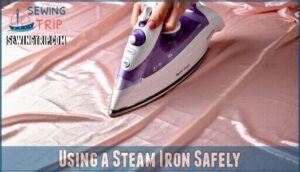This site is supported by our readers. We may earn a commission, at no cost to you, if you purchase through links.

Store your satin on padded hangers in breathable garment bags, and always hang pieces immediately after wearing them. When wrinkles appear, steam ironing between 110°C and 150°C works best, though handheld steamers and even your shower’s humidity can lift creases without risking scorch marks.
What matters most is knowing how your specific satin handles heat and moisture.
Table Of Contents
Key Takeaways
- Satin wrinkles easily due to its weave structure with exposed floating threads, though polyester satin resists creasing far better than silk satin, which wrinkles from even light pressure. – Prevent wrinkles by storing satin on padded hangers in breathable garment bags, hanging pieces immediately after wearing, and avoiding cramped storage that increases creasing by 33%. – Remove wrinkles safely using steam ironing at 110°C to 150°C with a press cloth, handheld steamers held 2-3 centimeters away, or bathroom humidity from hot showers for 15-20 minutes. – Always wash satin in cold water with gentle detergent and air dry flat or on padded hangers, since hot water causes 60% more shrinkage and dryer heat sets wrinkles permanently into the fabric.
Does Satin Wrinkle Easily?
Yes, satin wrinkles easily, and understanding why helps you protect your favorite pieces.
Satin wrinkles because of its weave structure, the fiber type used, and how you handle it.
Why Satin Shows Wrinkles
Satin’s weave structure is the culprit here. Long, floating threads sit exposed on the surface, and they grip creases much more stubbornly than tightly woven fabrics like twill or canvas.
Studies have found this makes satin two to three times more wrinkle-prone.
Fiber type matters too—silk satin wrinkles easier than polyester blends. Fabric thickness, storage impact, and humidity effects all play roles in how your satin garments hold up against creasing.
Types of Satin and Wrinkle Resistance
Not all satin wrinkles the same—fiber composition and weave structure determine how your garment holds up. Polyester satin leads the pack for wrinkle resistance, bouncing back after washing and wear. Silk satin, though luxurious, wrinkles fastest and demands careful handling.
Different satin types wrinkle differently:
- Polyester satin retains shape exceptionally well, resisting creases even after extended use.
- Silk satin shows visible wrinkles after light pressure, requiring frequent maintenance.
- Synthetic blends (like silk-polyester) balance beauty with practicality, wrinkling less than pure silk.
Thickness matters too—heavier satins exceeding 200 grams per square meter resist bunching better than lightweight versions. The wrinkle resistance can vary depending on whether it’s warp or weft faced.
Knowing these differences saves you headaches down the line, especially when picking satin for specific projects or garments.
Factors That Increase Satin Wrinkling
Even if you pick the right satin, how you handle and store it makes all the difference. Stuff a garment into a cramped drawer, and even resilient polyester blends end up wrinkled.
Humidity softens the fabric, making thin satin crease permanently. Poor handling—like folding haphazardly or hanging without care—undoes whatever advantages a tighter weave might offer.
Once environmental factors enter the picture, fiber type becomes a footnote. What really matters is how you protect the fabric day to day.
How to Prevent Wrinkles in Satin
The best way to deal with satin wrinkles? Don’t let them happen. A few simple habits can keep your satin smooth from the start.
Proper Storage Methods
How you store your satin garments can mean the difference between a smooth, ready-to-wear piece and a wrinkled mess that demands urgent attention. Research shows that overcrowding storage spaces increases creasing by 33%, so give your satin room to breathe.
Padded hangers prevent shoulder dimples, while breathable garment bags cut visible wrinkles by 50% over six months. Skip tight folding techniques for long-term storage—hanging is your best defense against persistent wrinkles.
Choosing The Right Hangers and Garment Bags
The right hanger matters more than you’d think for keeping satin smooth. Padded ones spread weight across the shoulders, instead of creating pressure points that leave permanent dimples.
Wood or cushioned hangers work best—they support the fabric without stressing delicate weaves.
- Padded vs. slim: Cushioned designs reduce pressure points that cause permanent creases in satin storage methods
- Bag breathability: Acid-free storage with ventilated garment bags prevents moisture buildup and wrinkle formation
- Length coverage: Full-length garment storage protects hems from floor contact and dust accumulation
- Hanger spacing: Leave 2–3 inches between items for best wrinkle prevention in satin
Handling and Wearing Tips
The moment you slip into satin, every movement becomes a negotiation between elegance and those stubborn creases that seem to appear out of nowhere.
For everyday wear and event preparation, handle satin gently—avoid bunching fabric when sitting or accessorizing satin pieces. Keep comfort considerations in mind by limiting jewelry that snags delicate weaving.
Quick stain prevention matters too: blot spills immediately rather than rubbing. After wearing, return items promptly to padded hangers, reinforcing your satin storage methods and wrinkle prevention in satin efforts while caring for satin garments properly.
Air Drying and Immediate Hanging
Timing makes all the difference—pulling satin from the dryer or washing line and hanging it immediately can slash wrinkle formation by more than half. When you air dry satin, proper airflow importance becomes clear: good circulation speeds drying and reduces creases.
Use padded hangers for garment storage, confirming immediate actions matter. This simple drying technique delivers major wrinkle reduction, protecting your investment while caring for satin clothing effectively.
Best Methods to Remove Wrinkles From Satin
Once wrinkles show up, you need methods that actually work without harming the fabric. These techniques will get your satin looking smooth again.
Using a Steam Iron Safely
Steam ironing satin takes a careful touch. Set your iron between 110°C and 150°C—always err on the cooler side to avoid melting synthetic fibers.
Turn garments inside out, use a thin protective cloth, and glide in short strokes without lingering. To prevent damage, always use a pressing cloth. Keep steam settings minimal or off entirely to dodge water spots, and select equipment with reliable heat control to eliminate damage risks.
Steaming With a Handheld Steamer
Handheld steamers work like a gentle spa treatment for satin, lifting wrinkles without the harsh contact that irons demand.
Hold your hand steamer 2–3 centimeters away from the satin fabric and move in steady, sweeping motions from bottom to top. Use distilled water to prevent mineral spotting, and place a clean white sock over the steamer head for extra fabric protection.
A 15-minute steaming duration usually smooths most wrinkles—just let your garment air dry completely afterward.
Shower Steaming Techniques
Your bathroom shower can double as a wrinkle-fighting secret weapon when you’re traveling or don’t have a steamer on hand. Run hot water until steam fills the space, then hang your satin garment nearby—but not directly under the spray.
- Best shower setup: Keep the hot bathroom closed for 10–15 minutes to build consistent steam
- Garment hanging methods: Use a sturdy hanger on the shower rod or towel hook, positioned away from water contact
- Steam time duration: Allow 15–20 minutes for wrinkles to relax naturally
- Fabric safety checks: Check satin afterward to check no moisture damage or spotting occurred
This gentle steam ironing alternative works beautifully for removing wrinkles from satin without direct heat contact.
Ironing With a Press Cloth
When shower steam doesn’t get wrinkles out completely, grab your iron and a press cloth. You’ll get much crisper results, and the press cloth protects the fabric from heat damage.
Flip your garment inside out, set the iron to low (110–150 °C), and lay a clean cotton cloth between the iron and satin. Keep moving in smooth strokes—don’t let it sit in one spot—and you’ll smooth out wrinkles without scorching or dulling the finish.
Turn your garment inside out, set your steam iron to low temperature (110–150 °C), and place a clean cotton press cloth between the iron and fabric. Use smooth, sweeping strokes—never let the iron sit still—to safely remove wrinkles without damaging satin’s delicate weave.
How to Remove Wrinkles From Satin Without an Iron
An iron isn’t your only option for smoothing satin. Several gentler, heat-free methods work just as well.
Here are four practical techniques you can use when an iron isn’t available or when you want to be extra cautious with delicate fabric.
Mist Spraying and Air Drying
When you don’t have an iron handy, a simple spray bottle filled with clean water can work wonders on wrinkled satin. Lightly mist the fabric—don’t soak it—then hang your garment in a well-ventilated space.
As the satin air-dries, gravity gently pulls the wrinkles out, restoring smoothness without heat or pressure on the delicate weave.
Using Wrinkle-Release Sprays
For an even faster fix, wrinkle-release sprays offer a targeted solution that relaxes fabric fibers on contact. Look for formulas compatible with delicate satin fabric—many contain gentle fabric softeners that smooth wrinkles without leaving residue or overpowering scents.
Just spray lightly over the wrinkled areas, then let your garment hang while the solution does its work, restoring that sleek finish you’re after.
Hanging in a Humid Bathroom
One surprisingly effective trick turns your morning shower into a makeshift wrinkle-removal tool—no spray bottle required. Hang your satin garment in the bathroom while you shower, keeping the door closed to trap steam.
The humidity benefits delicate fabrics by relaxing fibers naturally, and about 15 minutes of hanging duration works wonders for removing wrinkles from satin without risking heat damage or water spots.
Gentle Hand Smoothing
Sometimes the simplest approach works best—smoothing satin wrinkles by hand takes patience, but it’s surprisingly effective when you’re caught without any equipment.
Lay the garment flat and use gentle pressure with your palms, working from the center outward in slow strokes. This fabric manipulation technique allows your body heat to relax the fibers while your hands guide the wrinkles away, making it perfect for daily care of delicate fabrics when you need quick touch-ups.
Extra Tips for Caring for Satin Garments
Once you’ve got steaming and ironing down, a few other habits will keep your satin wrinkle-free for the long haul.
A few other habits beyond steaming and ironing will keep your satin wrinkle-free when you wash it, pack it for travel, or wear it day to day.
Washing and Drying Recommendations
Hand washing satin in cool water with mild detergent is your safest bet—it preserves fiber integrity and reduces shrinkage by over 60% compared to hot water washing.
If you must use a machine, choose the delicate cycle, place your satin in a mesh bag, and stick with cold water.
After washing, lay your satin flat on a towel and roll it gently to remove excess water, then air dry away from direct sunlight to maintain that signature luster and minimize wrinkles.
Preventing Wrinkles During Travel
Satin wrinkles easily, but smart packing keeps it looking sharp. Here’s what works:
- Use a travel garment bag to protect satin from pressure and friction
- Roll lightweight satin items loosely with tissue paper between folds
- Layer heavier pieces flat with padded hangers for structured backing
- Steam immediately upon arrival using hotel bathroom humidity or a handheld steamer
These protective packing methods prevent most wrinkles before they form.
Daily Maintenance for Satin Clothing
Keeping satin smooth means building habits that stop wrinkles before they start.
Once you’ve worn satin, hang it right away on padded hangers to hold its shape and keep the fabric from creasing.
Spot-clean stains promptly with gentle cleaning methods, and use revitalizing sprays between washes to keep the fabric fresh.
Store items in a breathable garment bag, check them routinely for proper folding, and you’ll preserve satin fabric care without constant intervention.
Frequently Asked Questions (FAQs)
What temperature should you wash satin at to avoid wrinkles?
Cold water protects satin’s structure. Wash on gentle with mild detergent to keep the fabric smooth and wrinkle-free.
You should wash satin at cold temperatures, using a gentle detergent and delicate cycle settings to prevent wrinkles and preserve the fabric’s smooth weave structure and fiber composition.
Does putting satin in the dryer cause wrinkles?
Yes, dryer heat damages satin fibers and sets wrinkles deeply into the fabric. High tumble settings worsen wrinkle severity, so air drying is your best alternative for removing wrinkles from satin and keeping the weave smooth.
Can you tumble dry satin?
Can you tumble dry satin? You shouldn’t, since heat damage from dryer settings causes fiber damage and persistent wrinkles in satin fabric, especially synthetic fibers.
Tumble-dry risks include scorching and texture loss, so stick with drying alternatives like air-drying to keep your garments smooth.
Does satin shrink when washed?
Satin can shrink when washed, especially if you use hot water or high heat during drying. The amount of shrinkage depends on the fiber composition—natural fibers shrink more than polyester satin.
To prevent shrinkage, always wash in cold water and air dry your satin fabric.
How do you wash satin sheets to prevent wrinkles?
Use cold water with gentle detergents when washing satin sheets. Place them in mesh bags, select a delicate cycle, then air dry or tumble dry on low to keep the satin fabric smooth and wrinkle-free.
Can Satin Be Treated to Resist Wrinkles?
You can’t fully wrinkle-proof satin fabric, but certain treatments help. Chemical treatments and protective coatings improve wrinkle resistance, especially when combined with synthetic fibers like polyester.
Newer nanotechnology solutions and fiber blends offer better results than traditional satin weaves, maintaining satin’s signature smoothness longer.
What Causes Satin to Wrinkle During Wear?
When you slip on a satin dress, body heat and friction at movement points like elbows and hips soften the fiber types, allowing the weave structure to shift and trap wrinkles.
Especially if humidity exposure adds moisture to synthetic fibers or natural satin fabric.
How Does Humidity Affect Satin Fabric Wrinkles?
Humidity acts like a magnet for wrinkles in satin fabric. High moisture levels weaken fiber structure and reduce weave density’s natural tension, making storage conditions critical.
Poor ventilation effects increase creasing, especially in synthetic satin types.
Are There Professional Wrinkle Removal Services for Satin?
When your satin needs serious help, turning to a professional dry cleaner makes all the difference.
They know how to restore delicate fabrics using expert steam cleaning, targeted stain removal, and special treatments to smooth out wrinkles.
Dry cleaners trained in couture alterations and wedding dress care use professional steaming services to safely restore your satin’s original smoothness without risking damage.
Does Satin Quality Impact Its Wrinkling Tendency?
Absolutely—higher quality satin resists wrinkles better. Excellent fiber composition, tighter weave density, higher thread count, and professional finish application all contribute to smoother fabric.
Polyester satin with spandex blends outperforms basic silk satin in wrinkle resistance.
Conclusion
Keeping satin wrinkle-free comes down to a few simple habits, but skip them and you’ll be dealing with creased fabric constantly. Store your pieces on padded hangers and use a steamer at the right heat setting—that’s how you maintain crisp-looking satin without making it complicated.
The best approach is stopping wrinkles before they form—hang everything right after you take it off and use breathable garment bags for storage. If wrinkles show up anyway, low heat and a bit of moisture will smooth them out without harming the fabric.
- https://vishimex.com/top-10-wrinkle-resistant-fabrics-commonly-used-in-fashion/
- https://www.masterclass.com/articles/what-is-satin-fabric-a-guide-to-the-types-characteristics-and-uses-for-satin
- https://www.ijera.com/papers/Vol7_issue1/Part-2/B0701020510.pdf
- https://pmc.ncbi.nlm.nih.gov/articles/PMC9415022/
- https://www.ever-pretty.com/blogs/blog/how-to-get-wrinkles-out-of-a-satin-dress
















